Introduction to Sustainable Flexible Roofing Membranes Design
Sustainable Flexible Roofing Membranes building design is no longer a niche concept; it has become a global priority. Architects, contractors, and green building enthusiasts aim to design structures that minimize environmental impact, promote energy efficiency, and ensure economic viability over their lifecycle. Central to these efforts is the selection of materials that support eco-friendly practices while maintaining performance and durability.
Among the many components of a building, the roofing system plays a crucial role. It directly influences energy consumption, weather resistance, and long-term sustainability. One standout innovation in this area is flexible roofing membranes. Lightweight yet sturdy, these materials are transforming green building design by addressing environmental challenges while ensuring optimal performance.
This blog explores the significance of flexible roofing membranes in sustainable construction, highlighting their types, benefits, successful applications, challenges, and future trends.
The Importance of Roofing Systems in Green Buildings
Roofing systems in green buildings are more than weather barriers—they are integral to energy efficiency, thermal regulation, and environmental sustainability. A well-chosen roofing material can dramatically reduce heat transfer, which lowers the reliance on energy-intensive heating and cooling systems.
Key requirements for roofing systems in sustainable designs include:
- Thermal Efficiency: The ability to reduce a building’s overall energy needs.
- Durability: Long-lasting materials reduce frequent replacements and associated waste.
- Environmental Impact: Materials should have a low carbon footprint in production and disposal and ideally be recyclable or biodegradable.
Flexible roofing membranes have emerged as a preferred solution to meet these criteria.
What Are Flexible Roofing Membranes?
Flexible roofing membranes are thin, lightweight, and highly durable materials designed to provide reliable protection against environmental elements. Applied as a continuous layer, these membranes are most commonly used in low-slope and flat roofing systems.
Characteristics of flexible roofing membranes include:
- High resistance to weather conditions such as UV radiation, wind, and heavy rainfall.
- Flexibility to adapt to roof movements caused by thermal expansion or contraction.
- Excellent waterproofing capabilities.
Types of Flexible Roofing Membranes
1. Thermoplastic Polyolefin (TPO)
TPO membranes are a popular choice due to their combination of durability and energy efficiency. Made from a blend of polypropylene and ethylene-propylene rubber, TPO is:
- Highly reflective, reducing heat absorption.
- Resistant to UV radiation, algae, and mold.
- Durable, with excellent seam strength.
TPO is commonly used in commercial roofing applications and is well-suited for regions with high solar exposure.
2. Polyvinyl Chloride (PVC)
PVC membranes are known for their strength and versatility. They are:
- Resistant to chemicals, fire, and punctures.
- Available in various colors, making them aesthetically versatile.
- Easy to install due to their lightweight nature.
PVC membranes are ideal for buildings with flat or low-slope roofs, particularly in industrial settings.
3. Ethylene Propylene Diene Monomer (EPDM)
EPDM, often referred to as “rubber roofing,” is a synthetic rubber membrane prized for its longevity. Its features include:
- Exceptional resistance to UV rays and harsh weather.
- Cost-effectiveness due to relatively low installation and maintenance expenses.
- Availability in large sheets, reducing the number of seams and potential leak points.
EPDM is frequently used for residential and commercial roofs in varying climate conditions.
Benefits of Flexible Roofing Membranes
Flexible roofing membranes offer a wide array of benefits, making them a key choice in sustainable building design.
1. Durability and Longevity
These membranes are designed to withstand extreme weather conditions, including intense sunlight, heavy rain, and strong winds. Their long lifespan reduces the need for frequent replacements, which minimizes waste and resource use.
2. Energy Efficiency and Reflectivity
Certain roofing membranes, such as TPO and PVC, are designed for high solar reflectivity. They help deflect sunlight, reducing heat transfer to the building interior. This results in:
- Lower cooling costs during hot weather.
- Contribution to “cool roofing” standards that combat urban heat islands.
3. Recyclability and Environmental Impact
Flexible roofing membranes often have a lower environmental impact than traditional materials. For instance:
- TPO and PVC membranes can be recycled at the end of their life cycle.
- Some manufacturers produce these membranes using eco-friendly processes that incorporate recycled materials.
By choosing sustainable membranes, buildings can improve their green certifications, such as LEED (Leadership in Energy and Environmental Design).
Case Studies: Successful Implementations
Project Alpha Headquarters
Location: California, USA
The corporate headquarters of Project Alpha, a major tech company, utilized TPO membranes for their 100,000-square-foot roof. This choice reduced cooling costs by 25% annually while meeting stringent environmental compliance standards.
Greenfield Apartments
Location: London, UK
This residential complex integrated EPDM roofing membranes, selected for their cost-effectiveness and resistance to harsh weather conditions. The solution reduced repair and maintenance costs by 40% over 15 years.
Industrial Plant Upgrade
Location: Bengaluru, India
A PVC membrane was installed during the renovation of a manufacturing facility. Its chemical-resistant properties ensured roof durability, while improved insulation reduced energy consumption by 30%.
Challenges and Considerations
Despite their benefits, flexible roofing membranes also come with challenges, including:
- Initial Costs: High-quality membranes can have a higher upfront cost compared to traditional materials. However, their long-term benefits often outweigh the investment.
- Skilled Installation: Proper installation is critical for optimal performance. Expertise in handling and sealing membranes is necessary, which may limit contractor options in some areas.
- Material Compatibility: Compatibility with existing roofing structures must be evaluated carefully to avoid incompatibility issues.
Future Trends in Flexible Roofing Membranes
Flexible roofing membranes continue to evolve, driven by advancements in material technology and environmental regulations. Expect the following trends to shape the future:
- Smart Roofing Materials: Integration of sensors to monitor roof performance.
- Enhanced Recyclability: Development of membranes made from 100% recycled materials.
- Greater Adoption of Renewable Energy Systems: Compatibility with solar panel installations, further boosting energy efficiency.
The Future is Flexible and Green
Flexible roofing membranes represent the marriage of durability, performance, and sustainability—a solution perfectly aligned with the goals of sustainable building design. For architects and contractors seeking to create environmentally conscious buildings, these membranes provide an ideal roofing option.
By making thoughtful material choices today, we pave the way for energy-efficient, eco-friendly buildings that can stand resiliently against the changing climate.
Interested in incorporating flexible roofing membranes into your next project? Explore our catalog and consult with our experts to ensure you select the perfect solution for your sustainable design goals. Your green building aspirations are just a decision away.


2 Comments
Pingback: Coyyn.com Business – Digital Banking for Entrepreneurs
Pingback: Drive Social Media Lawsuit & Its Impact on Marketing Ethics